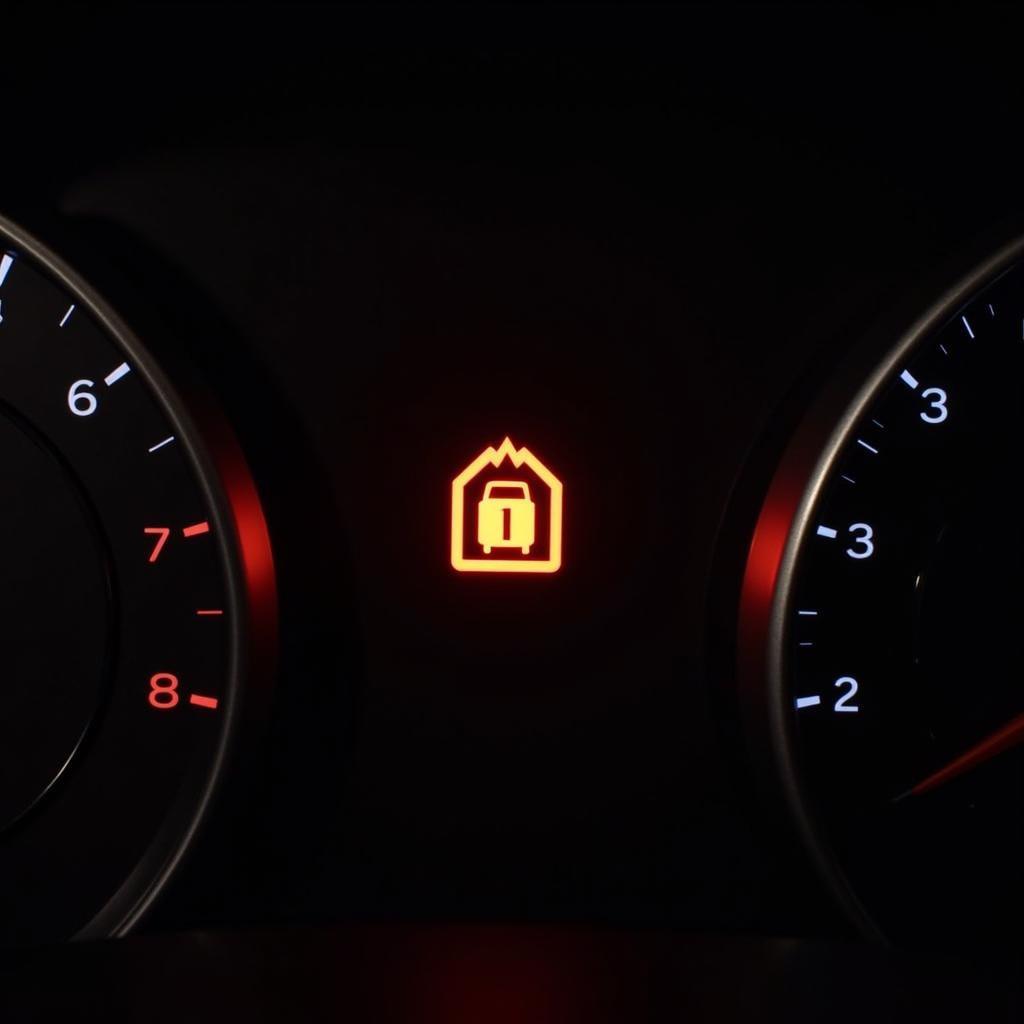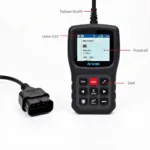The OBD2 code P2096 on your Dodge vehicle indicates a problem with the exhaust gas aftertreatment system. Specifically, it means that the engine control module (ECM) has detected a signal from the downstream oxygen sensor that is outside of the normal operating range, suggesting an issue with the catalytic converter’s efficiency. This article will delve into the intricacies of this code, its symptoms, common causes, and potential solutions.
Understanding OBD2 Code P2096
The “P2096” code translates to “Post Catalyst Fuel Trim System Too Lean Bank 1”. Let’s break down what this means:
- Post Catalyst: This refers to the exhaust system’s section after the catalytic converter.
- Fuel Trim System: This system adjusts the air-fuel mixture entering the engine to maintain optimal combustion and emissions control.
- Too Lean: The engine is running with an excessively high air-to-fuel ratio, meaning there’s too much oxygen compared to fuel.
- Bank 1: This indicates the side of the engine where the issue is detected. In engines with two cylinder banks, Bank 1 typically refers to the side containing cylinder #1.
Essentially, the P2096 code suggests that the oxygen sensor downstream of the catalytic converter is detecting a lean condition, which could point to a problem with the catalytic converter itself or other components affecting its performance.
Recognizing Symptoms of the P2096 Code
While the check engine light is a primary indicator, your Dodge might exhibit other symptoms when the P2096 code is present:
- Decreased Fuel Efficiency: A lean fuel mixture can lead to reduced fuel economy.
- Rough Engine Performance: You might experience hesitation, stumbling, or a lack of power, particularly during acceleration.
- Engine Misfires: In some cases, a lean condition can cause engine misfires, leading to further performance issues.
- Failed Emissions Test: A malfunctioning catalytic converter, a potential cause of the P2096 code, can result in your vehicle failing an emissions test.
Common Causes of OBD2 Code P2096 in Dodge Vehicles
Understanding the potential causes of the P2096 code is crucial for effective diagnosis and repair. Here are some of the most common culprits:
-
Faulty Oxygen Sensor (O2 Sensor): While the code suggests a problem after the catalytic converter, a faulty downstream oxygen sensor itself can sometimes trigger the P2096 code.
-
Exhaust Leaks: Leaks in the exhaust system, particularly before or near the downstream oxygen sensor, can disrupt exhaust gas flow and lead to inaccurate readings, triggering the code.
-
Catalytic Converter Issues: The P2096 code often points to a problem with the catalytic converter. This could involve:
- Catalyst Degradation: Over time, the catalyst material inside the converter can degrade, reducing its efficiency.
- Catalyst Poisoning: Certain substances, such as engine oil or coolant leaking into the exhaust, can damage the catalyst and impair its function.
-
Fuel System Problems: Issues within the fuel system can cause a lean fuel mixture, potentially triggering the P2096 code. This might include:
- Clogged Fuel Filter: A restricted fuel filter can impede fuel flow to the engine, leading to a lean condition.
- Malfunctioning Fuel Injectors: Faulty fuel injectors might not deliver the correct amount of fuel, disrupting the air-fuel ratio.
- Fuel Pressure Issues: Low fuel pressure, often caused by a failing fuel pump, can result in an insufficient fuel supply to the engine.
-
Vacuum Leaks: Leaks in the engine’s vacuum system can introduce unmetered air, upsetting the air-fuel balance and potentially leading to a lean condition that triggers the P2096 code.
-
Engine Control Module (ECM) Problems: While less common, a malfunctioning ECM can sometimes incorrectly interpret sensor data and erroneously set the P2096 code.
Diagnosing and Fixing the P2096 Code
Pinpointing the exact cause of the P2096 code requires a systematic approach. Here’s a step-by-step guide:
1. Read the Code: Begin by using an OBD2 scanner to read the trouble codes stored in your Dodge’s ECM. Confirm the presence of the P2096 code and check for any other related codes that might offer further clues.
2. Inspect for Exhaust Leaks: Visually inspect the exhaust system, paying close attention to areas around the catalytic converter and downstream oxygen sensor, for any signs of leaks, such as cracks, holes, or loose connections.
3. Check the Downstream Oxygen Sensor: Inspect the downstream oxygen sensor for damage or contamination. Test its operation to ensure it’s sending accurate signals to the ECM.
4. Examine the Catalytic Converter: Assess the catalytic converter for signs of physical damage, excessive heat discoloration (which could indicate overheating), or a rattling sound (suggesting internal damage).
5. Inspect Fuel System Components: Check the fuel filter for clogging and replace it if necessary. Inspect the fuel injectors for proper operation. Assess the fuel pressure using a fuel pressure gauge to ensure it meets the manufacturer’s specifications.
6. Check for Vacuum Leaks: Inspect all vacuum hoses and connections for leaks. A hissing sound or a noticeable change in engine idle speed when spraying carburetor cleaner around potential leak points can indicate a vacuum leak.
7. Consult a Professional Mechanic: If the problem persists after these checks, it’s advisable to consult a qualified mechanic specializing in Dodge vehicles. They have the expertise, specialized tools, and diagnostic equipment to accurately pinpoint and address the underlying issue triggering the P2096 code.
Conclusion: Taking Action on the P2096 Code
Addressing the OBD2 code P2096 promptly is crucial to prevent further engine damage, optimize fuel economy, and ensure your Dodge vehicle runs smoothly and efficiently. By understanding the meaning, symptoms, common causes, and diagnostic steps outlined in this article, you’ll be better equipped to tackle this issue head-on. Remember, if you encounter any difficulties or need expert assistance, don’t hesitate to contact a trusted mechanic specializing in Dodge vehicles.
FAQs about the P2096 Code in Dodge Vehicles
1. Can I still drive my Dodge with a P2096 code?
While you might be able to drive short distances, it’s not advisable to ignore this code. Driving with a lean condition for extended periods can potentially damage your engine.
2. Is it safe to clear the P2096 code myself?
Clearing the code will temporarily turn off the check engine light but won’t fix the underlying issue. It’s crucial to address the root cause to prevent further problems.
3. How much does it cost to fix the P2096 code?
The repair cost depends on the specific cause. Simple fixes like replacing an oxygen sensor or fixing an exhaust leak will be less expensive than replacing a catalytic converter.
4. Can a bad catalytic converter damage my engine?
Yes, a severely clogged catalytic converter can restrict exhaust flow, potentially leading to engine damage over time.
5. Can using the wrong type of fuel trigger the P2096 code?
Using fuel with an incorrect octane rating is unlikely to directly cause the P2096 code. However, consistently using low-quality fuel can contribute to catalytic converter issues over time.
Need More Help?
For personalized assistance with your car trouble codes or to explore our range of top-rated OBD2 scanners, don’t hesitate to reach out! Our expert team is available 24/7 via WhatsApp: +1(641)206-8880 or Email: [email protected]. We’re here to help you get back on the road with confidence!


